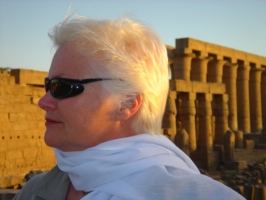There are 36 bridges that cross the Seine river in Paris. If I walk straight south from my apartment, I cross the river at Pont Neuf, the “New Bridge.” This is a bit confusing, since “neuf” also means “nine” in French. There is a bar near me on Rue de Pont Neuf called “Pont 9.” Even more confusing is the fact that Pont Neuf is Paris’ oldest standing bridge, built 1578-1607. But this bridges’ 12 arches were new at the time since their design did not include the usual homes and other buildings sprouting on top.
Post Neuf is my closest way to cross the river, so it’s my home bridge. Actually Pont Neuf crosses the Seine twice as the bridge slices through the western prow tip of the river island Ile de la Cite.
After Henri III laid the first stone for Pont Neuf, his son Henry IVÂ got the bridge finished. A bronze Henri IVÂ sits astride a horse in a large, pigeon-stained statue on the west side of the bridge. This is actually the second try at a statue of Henri since the first one was destroyed during the French Revolution in 1792.
Henri VI reigned for 57 years (1553-1610) and was grandfather to Louis XIV. Grandpa Henri’s nickname, Vert-Galant (Green Knight), is also the name of the park (Parc Vert Galant) at the western tip of the island (see the tree-lined park in the middle of the image below). Even with all the picnickers and kids, I love this little park. On my last visit to Vert Galant, there was a couple on the absolute tip toasting each other with wine in glasses while a bunch of school kids were showing off their dance moves.
 Â Â Â Â There are 300 stone faces that adorn Pont Neuf, each one different from the other. There are supposedly visages of 299 men and one woman.
    There are 300 stone faces that adorn Pont Neuf, each one different from the other. There are supposedly visages of 299 men and one woman.
Pierre Curie was killed on Pont Neuf by a horse-drawn carriage during a snowstorm or heavy rainstorm (I found citations for both) in April 1906. His skull was fractured under the carriage wheels, perhaps saving him a more agonizing death from the radiation exposure that eventually killed his wife, the Polish scientist Marie Sklowdowska-Curie in 1934.Â
Jacques de Molay, the 23rd and last Grand Master of the Knights Templar, was burned at the stake near Pont Neuf in 1314, an execution ordered by King Philippe le Bel. A plaque honoring De Molay is overhead as you exit the stairs from the bridge, facing west towards the park. There’s a stone face without facial hair to the far right of this plaque that may be the sole female figure on the bridge.
The Bulgarian installation artist Christo wrapped Pont Neuf in many yards of gold canvas in 1985 (see image below).Â
   In 1992, a disturbing historical installation decorated Pont Neuf to celebrate the 50th year of freedom from fascism. Swastikas were hung from the bridge during a recreation of then leader of the Free French government-in-exile (in England) Charles De Gaulle’s 1942 speech encouraging Frenchmen to resist the Nazis. The speech was rebroadcast from speakers on the obelisk at Place de la Concorde (“Place of Harmony”). While Pont Neuf was undergoing renovations in the 1990s, French director Leos Carax made the 1991 movie Les Amants du Pont-Neuf, “Lovers on the Bridge,” starring Juliette Binoche and Denis Lavant.
In 1992, a disturbing historical installation decorated Pont Neuf to celebrate the 50th year of freedom from fascism. Swastikas were hung from the bridge during a recreation of then leader of the Free French government-in-exile (in England) Charles De Gaulle’s 1942 speech encouraging Frenchmen to resist the Nazis. The speech was rebroadcast from speakers on the obelisk at Place de la Concorde (“Place of Harmony”). While Pont Neuf was undergoing renovations in the 1990s, French director Leos Carax made the 1991 movie Les Amants du Pont-Neuf, “Lovers on the Bridge,” starring Juliette Binoche and Denis Lavant.
Design newness, carriage accidents, burning at the stake, canvas wrapping, Nazi occupation recreations, renovations, movie-making, lovers toasting each other with wine: Pont Neuf has been the site of many things. All I require today is that it take me across the river for a cafe creme at Cafe des Beaux Arts.



Post a Comment